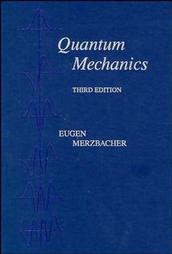
Instructor: Silas Beane
Office: Nesmith 307
Phone: 603-862-2720
email:
silas@physics.unh.edu web: http://nuclear.unh.edu/~silas/
Office hours: W Th 12:00-1:00pm
I strongly encourage students to communicate with me by email for
bureaucratic issues. At times, I'll communicate with the class by email.
Please, no physics questions via email!
If necessary, you may visit me outside of office hours but please do
not be offended if I'm unable to speak with you immediately.
The grades for this course will be based on homework (50%), an
in-class midterm exam (25%) and a
final exam (25%) that may be take-home or
may be in-class, depending on the overall class performance on the
mid-term. The final exam will be
comprehensive.
You will have two weeks to complete each homework set;
there will be
roughly seven homework assignments. The homeworks will be
long and
difficult. If you start working on an
assignment the day before
it's due, you will not finish it in time. Late homeworks will not be
accepted unless there is a compelling rationale.
I encourage you to work on the homework in groups. However, you must list your collaborators on
your
manuscript. I take this very seriously; a failure to acknowledge
collaborators
may result in a loss of all credit for the assignment. There is no
collaboration permitted on the exams.
I believe that most of what you'll get out of this class will be
from the homeworks. Several of the assigned problems will involve
numerical simulation.
Some useful texts
(on reserve in the library)
J.J. Sakurai, Modern Quantum Mechanics
C. Cohen-Tannoudji, B. Diu and F. Laloe, Quantum Mechanics
L.D. Landau and E.M. Lifschitz, Quantum Mechanics
(Non-relativistic theory)
E. Merzbacher, Quantum Mechanics
R. Shankar, Principles of Quantum Mechanics
A. Messiah, Quantum Mechanics
A. Das and A.C. Melissinos: Quantum Mechanics: A
Modern Introduction
A. Bohm: Quantum Mechanics: Foundations and Applications
A.S. Davydov: Quantum Mechanics
W.K. Tung Group Theory in Physics
(come see me if this isn't in library)
Calendar (topics covered & homework)
| Week | Monday | Wednesday | Friday | HW (due on Fridays) |
| 1.
9/3 |
Introduction Rotations in 2-d SO(2), its generator, and its representations |
HW1 (ps,pdf) |
||
| 2.
9/10 |
Silas
in Aachen (J.Dawson covering) Rotations in 3-d Axis and angle parametrization 3-d Rotations in QM |
John Dawson's notes (pdf) |
||
| 3.
9/17 |
Rotations in 2-d (continued) Angular momentum in 2-d Rotations in 3-d (continued) Classical 3-d rotations Algebra and invariant tensors of SO(3) generators and transformation properties |
HW2 (ps,pdf) HW1 due |
||
| 4.
9/24 |
Silas at JLab (no class Monday; meet
Wednesday and Friday) Rotations in 3-d (continued) More on axis and angles Euler angles SO(3) in QM eigenvalues and eigenvectors |
|||
| 5.
10/1 |
SO(3) in QM (continued) Wigner D functions Orbital angular momentum Spherical harmonics |
HW3 (pdf) HW2 due |
||
| 6.
10/8 |
SO(3) in QM (continued) Spherical harmonics (continued) Addition of angular momenta (Vector and) Tensor operators |
|||
7. 10/15 |
SO(3) in QM (continued) W-E theorem Time-dependent Perturbation Theory review of R-S time-ind. PT EXAM WEDNESDAY |
HW4 (pdf) HW3 due |
||
| 8.
10/22 |
Time-dependent Perturbation Theory Formalism Coulomb excitations |
|||
| 9.
10/29 |
Time-dependent Perturbation Theory (continued) Coulomb excitations Atom in a radiation field The photoelectric effect |
HW5 (pdf) HW4 due |
||
10. 11/5 |
Time-dependent Perturbation Theory (continued) The photoelectric effect (continued) Fermi's Golden rule Scattering Theory The S-matrix in 1-d |
|||
| 11.
11/12 |
Scattering Theory (cont) The scattering cross section Green's functions in scattering theory Scattering of a wave packet The Born approximation |
HW6 (pdf) HW5 due |
||
12. 11/19 |
Scattering Theory (cont) Central potentials Scattering amplitude and partial waves Phase shifts S matrix and optical theorem |
|||
13. 11/26 |
Scattering Theory (cont) The transition matrix and the S matrix The T matrix and relation to scattering amplitude Lipmann-Schwinger equation |
HW7 (pdf) HW6 due |
||
14. 12/3 |
Scattering Theory (cont) The nth Born approximation N particle systems Direct product spaces for distinguishable particles Entangled states Identical particles State vectors and permutation symmetry BE and FD statistics Two electron system Creation/annihilation operators operator algebra |
|||
15. 12/10 |
Creation/annihilation operators (cont) operator algebra (cont) BE and FD statistics |
HW7 due FINAL EXAM (pdf) Final exam due 12/20 |
||